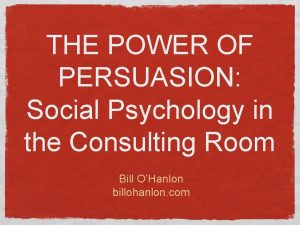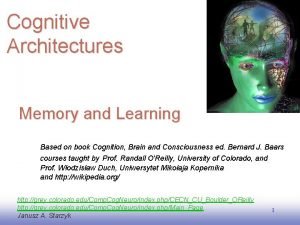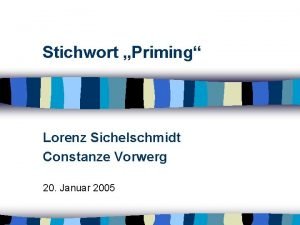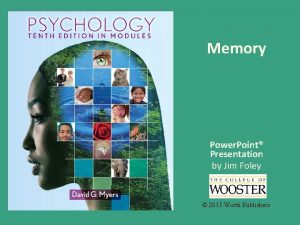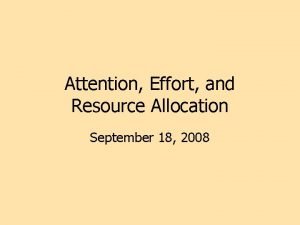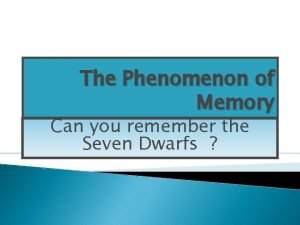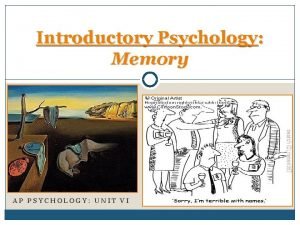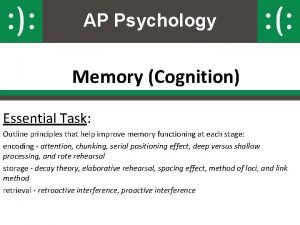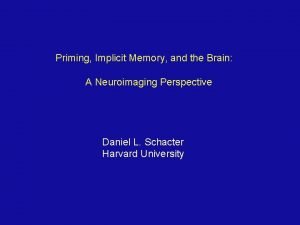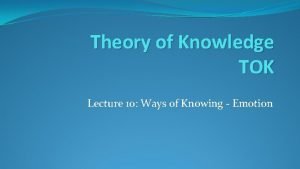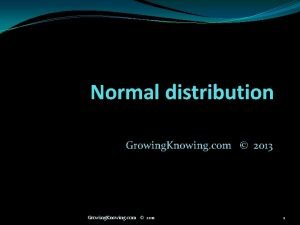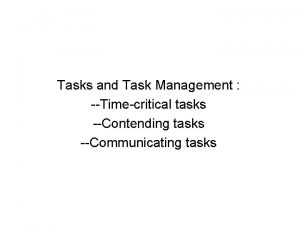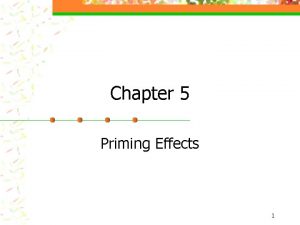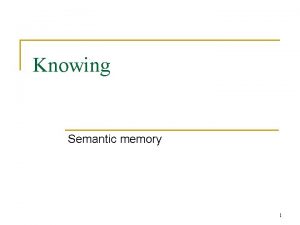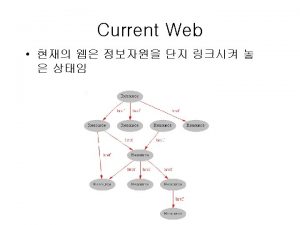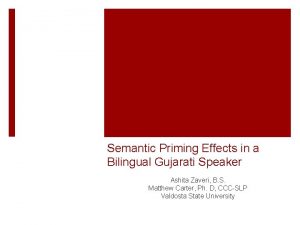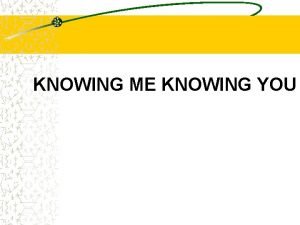1182022 Knowing Semantic Priming Priming Tasks Priming in





















- Slides: 21


1/18/2022 • Knowing » Semantic Priming ◊ Priming Tasks ◊ Priming in other tasks ◊ Automaticity » Neurophysiology II ◊ Context and connectionism ◊ The living/nonliving dissociation – Connectionist model of semantic impairment Study Questions. • Compare and contrast category-based and property-based representation. How does this distinction account for the living/non-living dichotomy in neuropsychological studies?

Knowing • Semantic Priming » Primes and targets ◊ Prime - The stimulus expected to have some effect on a subsequent stimulus. – Primes can be related e. g. , (DOCTOR -> NURSE) – Unrelated e. g. , (BUTTER -> NURSE) – Neutral e. g. , (XXXXX-> NURSE) ◊ Target - The stimulus expected to be effected by the prime.

Knowing • Semantic Priming » Priming across trials ◊ E. g. , Sentence verification task – Lag - the spacing between the prime and target

Knowing • Semantic Priming » Priming within trials ◊ SOA (Stimulus Onset Asynchrony) - The time between the onset of one stimulus and the onset of a subsequent stimulus. ◊ ISI (Inter-Stimulus Interval) - The time between the offset of one stimulus and the onset of a subsequent stimulus.

Knowing • Semantic Priming » Priming across and within: Loftus & Loftus (1974) ◊ Word generation task Trial n+1 Trial n+2 Trial n+3 Lag = 0 Lag = 2 Fruit - p Fruit - a Furniture - c Vehicle - t Fruit - p Furniture - c Vehicle - t Fruit - a

Knowing • Semantic Priming » Priming across and within: Loftus & Loftus (1974) 2. 3 Simultaneous Letter - category 1. 9 RT (s) 2. 0 Letter - category 2. 2 2. 5 SOA 2. 1 2. 0 1. 9 1. 8 1. 7 Category - letter 1. 6 Category - letter 1. 8 1. 5 Initial 0 Lag 2

Knowing • Semantic Priming » Lexical decisions: Meyer & Schvaneveldt (1971) ◊ Lexical Decision Task - A simple yes/no task in which a participant decides whether a string of characters is a word or not. ◊ Presented 2 strings in succession – Respond ‘Yes’ if both are words (27. 6 %) (8. 7 %) (7. 8 %) (6. 3 %) (2. 6 %)

Knowing • Semantic Priming » Automatic spread of activation: Neely (1977) ◊ Lexical decision task – Category-Exemplar e. g. , BIRD - robin Cost Benefit

Knowing • Semantic Priming » Automatic spread of activation: Neely (1977) ◊ Manipulated controlled processing – Shift in category occurred on the majority of trials – Used two categories (BODY and BUILDING) – Three conditions • No shift -> BODY - heart; BUILDING - window • Shift to expected category -> BODY - window; BUILDING - heart • Shift to unexpected category -> BODY - sparrow

Knowing • Semantic Priming » Automatic spread of activation: Neely (1977) ◊ Results

Knowing • Semantic Priming » As an implicit process ◊ Marcel’s (1983) study – Dichoptic Viewing - presenting different stimuli to each eye in an experiment. Threshold setting Prime Mask Critical ISI detection accuracy < 60 % Experiment Prime Mask Critical ISI Target

Knowing • Semantic Priming » As an implicit process ◊ Marcel’s (1983) study – Dichoptic Viewing - presenting different stimuli to each eye in an experiment. – Results First Letter String: Second Letter String Unassociated Associated Difference Masked Unmasked 590 ms 528 ms 597 ms 541 ms 62 ms 56 ms

Knowing • Neurophysiology of Semantic Memory II » Damasio et al. ◊ 30 brain damaged patients ◊ Three naming conditions 1. Famous faces 2. Animals 3. Tools ◊ 19 patients showed severe naming deficit – 7 naming faces – 5 naming animals – 7 naming tools

Semantic Memory • Neurophysiology of Semantic Memory Persons: 59. 8 Animals: 93. 3 Tools: 96. 0 Persons: 75. 5 Animals: 80. 1 Tools: 84. 5 Persons: 91. 7 Animals: 88. 3 Tools: 78. 5

Semantic Memory • Neurophysiology of Semantic Memory II » Damasio et al. ◊ PET scans of normal observers

Knowing • Parallel distributed semantic networks » Distributed representation ◊ Connectionist models

Knowing • Parallel distributed semantic networks Output Units Hidden Units Bias Units Input Units

Semantic Memory • Parallel distributed semantic networks Animal Bird Fish Pink Canary Edible Ostrich Dangerous Shark Yellow Salmon Move Swim Fly Bite Sing ISA can Wings has Gills can’t Feathers is Long Legs Skin Fins

Semantic Memory • Parallel distributed semantic networks » Damasio’s findings, revisited ◊ Neurophysiological evidence – Visual vs. functional features – Living vs. nonliving » Farah and Mc. Clelland’s Model ◊ Category vs. property based representation

Semantic Memory • Parallel distributed processing networks » Farah and Mc. Clelland’s Model ◊ Lesioning study
 Circle of knowing
Circle of knowing Not knowing is worse than knowing
Not knowing is worse than knowing Ecmo weaning criteria
Ecmo weaning criteria Insulin pen priming chart
Insulin pen priming chart Conceptual priming
Conceptual priming Priming in hplc
Priming in hplc Priming
Priming Conceptual priming
Conceptual priming Konzeptuelles priming beispiel
Konzeptuelles priming beispiel Priming memory
Priming memory Zoom lens model of attention
Zoom lens model of attention Priming memory examples
Priming memory examples Jenis jenis skema psikologi sosial
Jenis jenis skema psikologi sosial Memory storage is never automatic; it always takes effort
Memory storage is never automatic; it always takes effort Priming memory examples
Priming memory examples Priming memory
Priming memory Knowing my community
Knowing my community Growing knowing
Growing knowing Bound and free movements
Bound and free movements Tok emotion
Tok emotion Knowing you is a gift
Knowing you is a gift Growingknowing
Growingknowing




